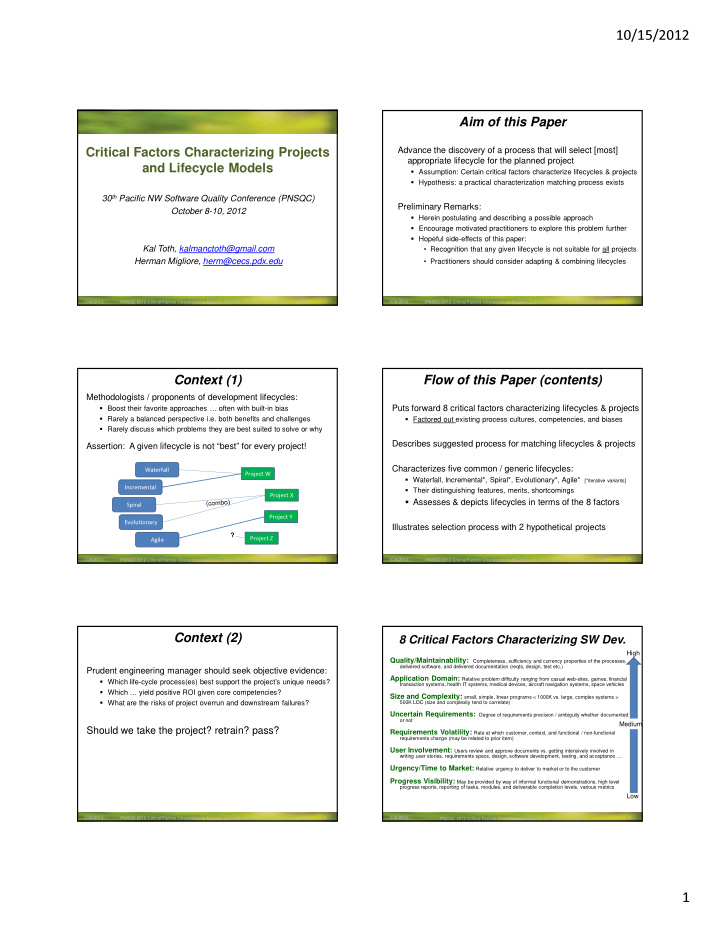



10/15/2012 Aim of this Paper Critical Factors Characterizing Projects Advance the discovery of a process that will select [most] appropriate lifecycle for the planned project and Lifecycle Models � Assumption: Certain critical factors characterize lifecycles & projects � Hypothesis: a practical characterization matching process exists 30 th Pacific NW Software Quality Conference (PNSQC) Preliminary Remarks: October 8-10, 2012 � Herein postulating and describing a possible approach � Encourage motivated practitioners to explore this problem further � Hopeful side-effects of this paper: Kal Toth, kalmanctoth@gmail.com • Recognition that any given lifecycle is not suitable for all projects Herman Migliore, herm@cecs.pdx.edu • Practitioners should consider adapting & combining lifecycles 10/8/2012 PNSQC 2012 Critical Factors Characterizing Projects and Lifecycle Models, presented by Kal Toth 1 10/8/2012 PNSQC 2012 Critical Factors Characterizing Projects and Lifecycle Models, presented by Kal Toth 4 Context (1) Flow of this Paper (contents) Methodologists / proponents of development lifecycles: Puts forward 8 critical factors characterizing lifecycles & projects � Boost their favorite approaches … often with built-in bias � Rarely a balanced perspective i.e. both benefits and challenges � Factored out existing process cultures, competencies, and biases � Rarely discuss which problems they are best suited to solve or why Describes suggested process for matching lifecycles & projects Assertion: A given lifecycle is not “best” for every project! Characterizes five common / generic lifecycles: Waterfall Project W � Waterfall, Incremental*, Spiral*, Evolutionary*, Agile* [*iterative variants] Incremental � Their distinguishing features, merits, shortcomings Project X � Assesses & depicts lifecycles in terms of the 8 factors Spiral Project Y Evolutionary Illustrates selection process with 2 hypothetical projects ? Project Z Agile 10/8/2012 PNSQC 2012 Critical Factors Characterizing Projects and Lifecycle Models, presented by Kal Toth 2 10/8/2012 PNSQC 2012 Critical Factors Characterizing Projects and Lifecycle Models, presented by Kal Toth 5 Context (2) 8 Critical Factors Characterizing SW Dev. High Quality/Maintainability: Completeness, sufficiency and currency properties of the processes, delivered software, and delivered documentation (reqts, design, test etc.) Prudent engineering manager should seek objective evidence: Application Domain: Relative problem difficulty ranging from casual web-sites, games, financial � Which life-cycle process(es) best support the project’s unique needs? transaction systems, health IT systems, medical devices, aircraft navigation systems, space vehicles � Which … yield positive ROI given core competencies? Size and Complexity: small, simple, linear programs < 1000K vs. large, complex systems > � What are the risks of project overrun and downstream failures? 500K LOC (size and complexity tend to correlate) Uncertain Requirements: Degree of requirements precision / ambiguity whether documented or not Medium Should we take the project? retrain? pass? Requirements Volatility: Rate at which customer, context, and functional / non-functional requirements change (may be related to prior item) User Involvement: Users review and approve documents vs. getting intensively involved in writing user stories, requirements specs, design, software development, testing, and acceptance … Urgency/Time to Market: Relative urgency to deliver to market or to the customer Progress Visibility: May be provided by way of informal functional demonstrations, high level progress reports, reporting of tasks, modules, and deliverable completion levels, various metrics Low 10/8/2012 PNSQC 2012 Critical Factors Characterizing Projects and Lifecycle Models, presented by Kal Toth 3 10/8/2012 6 PNSQC 2012 Critical Factors Characterizing Projects and Lifecycle Models, presented by Kal Toth 1
10/15/2012 Postulated Model Figure 2: Waterfall Lifecycle Model Characterized High 1. [Pre-condition]: each lifecycle characterized in terms of 8 critical factors collect, categorize and analyze data from a large sample of actual projects � 2. For each project, compile collected data from stakeholders (incl. cust/users): objectives, context, assumptions, resources, constraints and priorities � Medium 3. Prune candidate lifecycles eliminating the obvious including incompatibilities with competencies and culture 4. From compiled project data, assess / estimate nominal values for the 8 critical characterizing factors Low 5. Apply a matching algorithm to compare project’s characterization data with each lifecycle model’s profile Goal … estimate the “degree of fit” selecting the “best” � Size / Characterizing Factors Quality / Maintainability Application Domain Complexity Uncertain Requirements Progress Visibility Involvement Requirements Volatility Urgency / Time-to-Market User 6. Conduct sensitivity and trade-off analyses: Vary project characterization data � Incorporate project costing and scheduling estimates � 10/8/2012 PNSQC 2012 Critical Factors Characterizing Projects and Lifecycle Models, presented by Kal Toth 7 Iterative Lifecycle Models Figure 1: Waterfall Lifecycle Model [11] User Needs Iterative System Requirements Attributes Variants: WP, Incremental, Spiral, Evolutionary and Agile Repeated cycles, ongoing rework Software Requirements Parallel / concurrent development Benefits Parallel / concurrent development allows better schedules Formal Change Software Design than waterfall Control Advantages Early discovery of problems Implementation Customer feedback – more likely to meet requirements Visibility into progress Software Test Process improvement (PI), lessons learned (LL) Shortcomings Harder to manage project than waterfall System Test Disadvantages Harder to write contracts and subcontracts Acceptance Test 10/8/2012 PNSQC 2012 Critical Factors Characterizing Projects and Lifecycle Models, 8 10/8/2012 PNSQC 2012 Critical Factors Characterizing Projects and Lifecycle Models, presented by Kal Toth 11 presented by Kal Toth Waterfall Model Figure 3: Incremental Lifecycle Model [11] System Requirements Specification Waterfall Partitioned Attributes Relatively sequential with development phases, major Requirements milestones, & specified deliverables reviewed by stakeholders At each phase loop back to prev. phase to correct problems Formal change control procedures to correct problems in Architectural earlier phases which may modify costs and schedule Design Benefits Fosters thorough requirements, architecture and design before implementation Advantages Formalizes documentation and deliverables which facilitates Design Design project and contract management Partitions Specs Design Partitions Specs Shortcomings Not very adaptive to project changes or market demands Partitions Disadvantages Project visibility limited to documentation Customer and user feedback and refinement (too) late Incremental to incorporate lessons learned into the current project Incremental Builds Incremental Builds Builds 10/8/2012 PNSQC 2012 Critical Factors Characterizing Projects and Lifecycle Models, presented by Kal Toth 9 10/8/2012 PNSQC 2012 Critical Factors Characterizing Projects and Lifecycle Models, presented by Kal Toth 12 2
Recommend
More recommend